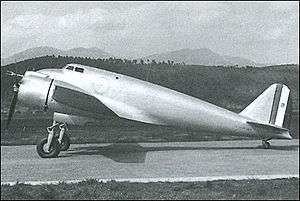Piaggio P.111
| Piaggio P.111 | |
|---|---|
 | |
| Role | High-altitude research aircraft |
| National origin | Italy |
| Manufacturer | Piaggio |
| First flight | 9 April 1941 |
| Introduction | 1941 |
| Retired | Early 1943 |
| Primary user | Regia Aeronautica (Italian Royal Air Force) |
| Number built | 1 |
|
| |
The Piaggio P.111 was an Italian high-altitude research aircraft designed and built by Piaggio for the Regia Aeronautica (Italian Royal Air Force).
Design and development
The genesis of the P.111 was in 1938, when the Regia Aeronautica awarded a contract to Piaggio to construct the prototype of a three-seat, twin-engine, high-speed, high-altitude bomber with a pressurized cabin. Especially for the P.111, Piaggio constructed a new radial engine, the 745 kW (999 hp) 18-cylinder double-row air-cooled Piaggio P.XII R.C.l00/2v, which was fitted with a two-stage supercharger.[1]
While the P.111 prototype was under construction, the Regia Aeronatica decided to use it as a high-altitude research aircraft rather than a bomber prototype.[1]
Operational history

The P.111 first flew on 9 April 1941. Employed in research related to pressurization of the cabin of the Piaggio P.108 heavy bomber, it made 110 test and research flights before being retired and scrapped early in 1943.[1]
Operators
Specifications
Data from Italian Civil & Military Aircraft 1930-1945[2]
General characteristics
- Crew: 3
- Length: 12.39838 m (40 ft 8.125 in)
- Wingspan: 17.30 m (56 ft 9 in)
- Height: 3.91 m (12 ft 10 in)
- Wing area: 40 m2 (430 sq ft)
- Empty weight: 5,239 kg (11,550 lb)
- Gross weight: 7,574 kg (16,698 lb)
- Max takeoff weight: 7,590 kg (16,733 lb)
- Powerplant: 2 × Piaggio P.XII R.C.l00/2v 18-cyl. air-cooled radial piston engines, 750 kW (1,000 hp) each
Performance
- Maximum speed: 575 km/h; 310 kn (357 mph) at 10,000 m (32,808 ft)
- Cruise speed: 449 km/h; 242 kn (279 mph)
- Range: 1,659 km; 896 nmi (1,031 mi)
- Service ceiling: 11,997 m (39,360 ft)
Notes
See also
References
External links
| Wikimedia Commons has media related to Piaggio P.111. |